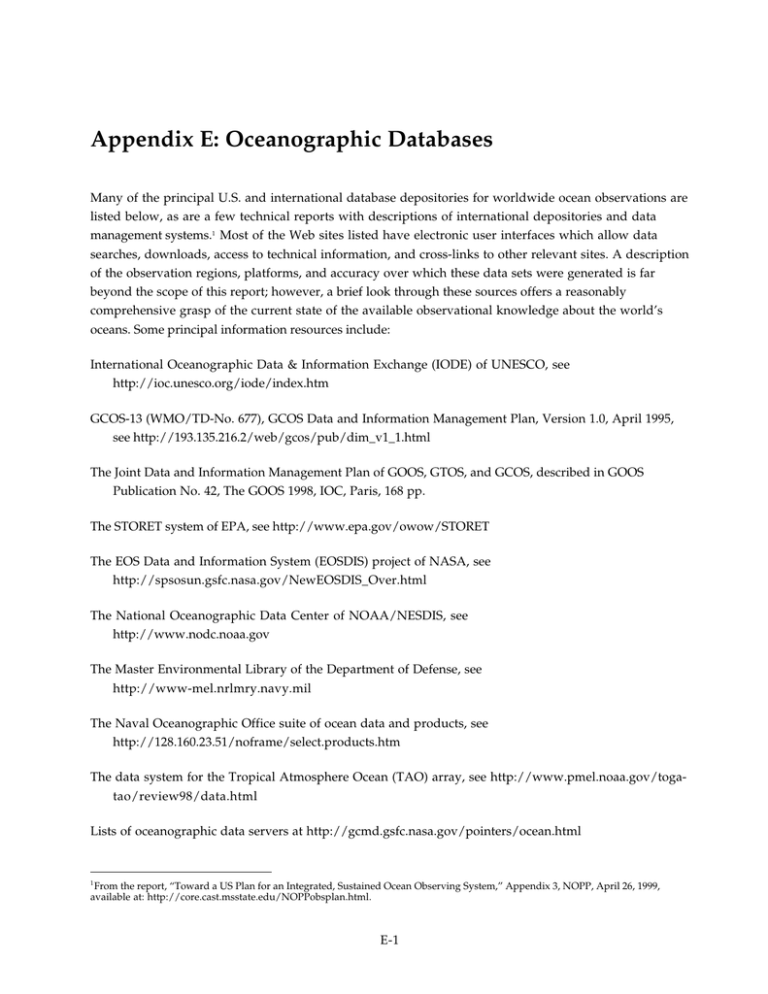Appendix E: Oceanographic Databases
advertisement

Appendix E: Oceanographic Databases Many of the principal U.S. and international database depositories for worldwide ocean observations are listed below, as are a few technical reports with descriptions of international depositories and data management systems.1 Most of the Web sites listed have electronic user interfaces which allow data searches, downloads, access to technical information, and cross-links to other relevant sites. A description of the observation regions, platforms, and accuracy over which these data sets were generated is far beyond the scope of this report; however, a brief look through these sources offers a reasonably comprehensive grasp of the current state of the available observational knowledge about the world’s oceans. Some principal information resources include: International Oceanographic Data & Information Exchange (IODE) of UNESCO, see http://ioc.unesco.org/iode/index.htm GCOS-13 (WMO/TD-No. 677), GCOS Data and Information Management Plan, Version 1.0, April 1995, see http://193.135.216.2/web/gcos/pub/dim_v1_1.html The Joint Data and Information Management Plan of GOOS, GTOS, and GCOS, described in GOOS Publication No. 42, The GOOS 1998, IOC, Paris, 168 pp. The STORET system of EPA, see http://www.epa.gov/owow/STORET The EOS Data and Information System (EOSDIS) project of NASA, see http://spsosun.gsfc.nasa.gov/NewEOSDIS_Over.html The National Oceanographic Data Center of NOAA/NESDIS, see http://www.nodc.noaa.gov The Master Environmental Library of the Department of Defense, see http://www-mel.nrlmry.navy.mil The Naval Oceanographic Office suite of ocean data and products, see http://128.160.23.51/noframe/select.products.htm The data system for the Tropical Atmosphere Ocean (TAO) array, see http://www.pmel.noaa.gov/togatao/review98/data.html Lists of oceanographic data servers at http://gcmd.gsfc.nasa.gov/pointers/ocean.html 1 From the report, “Toward a US Plan for an Integrated, Sustained Ocean Observing System,” Appendix 3, NOPP, April 26, 1999, available at: http://core.cast.msstate.edu/NOPPobsplan.html. E-1 The Distributed Oceanographic Data System (DODS) from the University of Rhode Island and the Massachusetts Institute of Technology, see http://rs.gso.uri.edu/DODS/home/home.html The World Ocean Circulation Experiment (WOCE) of the NSF has a data information unit, see http://www.cms.udel.edu/woce Metadata requirements of the Federal Geographic Data Committee, see http://www.fgdc.gov/metadata/metadata.html Oceanographic Databases of the Arctic Prior to the SCICEX cruises, the primary data collections efforts in the Arctic Ocean came from U.S. Navy nuclear submarines, and large Soviet activities that included ice camps and icebreakers. These data sets are not comprehensive, being both spatially and temporally sparse, and in addition most of them have been classified. With the advent of the international efforts to study global climate variability, this picture is changing rapidly as well. Currently, a concerted effort is under way within the United States and internationally to focus Arctic research efforts and develop more comprehensive observing systems, as well as to centralize large preexisting databases from previous observations. By far the largest single contribution of preexisting data came from the declassification of U.S. and former Soviet military oceanographic surveys. With the establishment of the Environmental Task Force in 1992 by the Director of Central Intelligence, at the behest of then-Senator Al Gore, various efforts were made to assess the possibility of declassifying large amounts of U.S. Navy oceanographic data assets. This resulted in the establishment of the MEDEA Special Task Force to examine the holdings of the Navy Meteorology and Oceanography Command; a 1995 report by that group gives a thorough overview of types of data then available.2 The MEDEA report was instrumental in spurring the declassification and eventual release of a significant amount of Navy oceanographic data. An even more substantial effort to assemble Arctic hydrographic data has been spurred by the U.S.-Russian Joint Commission on Economic and Technological Cooperation (the Gore-Chernomyrdin Commission). The Environmental Working Group (EWG) established by this Commission has facilitated the collection and distribution of large amounts of formerly classified environmental data from U.S. and Russian national security assets. Recently, the EWG Subgroup on Arctic Climatology has developed an electronic atlas of in situ Arctic Ocean data over a 40-year period, assembled from U.S., Russian, and Canadian data assets. This data is currently distributed openly via CD from the National Snow and Ice Data Center of NOAA. Another large source of in situ Arctic Ocean data has come from the six SCICEX cruises during the period of 1993–1999. These data were intended as a public scientific resource, and a variety of measurements were made of such variables as temperature, salinity, bathymetry, nutrients, and sea ice. A description of these data and many of the derived scientific studies is available in the report of the SCICEX 2000 2 “Scientific Utility of Naval Environmental Data,” MEDEA report, June 1995, available at: http://128.160.23.54/products/ PUBS/medea/navy_etf.html. E-2 Workshop.3 In addition, a significant amount of acoustic data on sea ice distributions from historical U.S. Navy nuclear submarine surveys has been declassified and released, and much more will be processed and released in the future.4 Although the Arctic is by far the least observed ocean, a variety of other data sets are available from many sources, consisting of a spectrum of platforms, sensor technologies, and physical variables. For example, NASA holds large databases of satellite data about the Arctic, and its developing Earth Observing System program will collect and integrate such data on a much larger scale. To summarize all of these data sets in Arctic we have cross-referenced the type of platform used for past observations (e.g. surface ship) versus the relevant physical observable measured (e.g. temperature) (see Table 8). Entries in the matrix are numbers that reference a short description of the particular database and contact information given at the end of this section. With regards to these entries, it should be noted that most of the large database sites now have cross-referenced links, and often contain the same data as other sources, hence we have typically tried to list only one major source for a given data type. Also, we have tended to list those data sites that are comprehensive, in order to give as compact a listing as possible. This table is not meant to be entirely inclusive of all available data, which is far beyond the scope of this report, rather it is meant to give a short overview of the available coverage of the Arctic region. In addition to the table entries, many other sites exist which contain comprehensive information about the Arctic, such as reports, bibliographies, metadata, and/or Web links to data depositories, research institutes, and program offices. A few of the major ones are listed below: (1) The International Arctic Environment Data Directory http://www.grida.no/add (2) The Arctic Climate System Study (ACSYS) of the WCRP http://www.npolar.no/acsys (3) The US Global Change Research Program http://www.gcdis.usgcrp.gov (4) The Arctic Environmental Data Center of the University of Cambridge, UK http://www.spri.cam.ac.uk/aemc/aemc.htm (5) The Master Environmental Library (MEL) of the Department of Defense http://mel.dmso.mil (6) Arctic Scientific and Technical Information System (ASTIS), Calgary University, Canada http://www.aina.ucalgary.ca/astis 3 “Arctic Ocean Science from Submarines,” report based on the SCICEX 2000 Workshop, April 1999, available at http://psc.apl.washington.edu/scicex/scicex2000.html. 4 Private communication, Dr. Drew Rothrock, APL–University of Washington. About 15 percent of the potential U.S. Navy declassified upward-looking sonar data has been processed to date, in conjunction with the Arctic Submarine Lab in SD, and further processing is in progress. E-3 Table E.1 Summary of Available Arctic Oceanographic Databases Platforms Submarines Surface Ships Satellites Buoys Human Stations Aircraft 4,5,6 1,4,6 4 1,4 1,4 * 5,6 1,3,6 3,6 1,3,6 1,3 6 5,6 1,4,6 4,6 1,3,6 1 * Ice Extent * 2,3,6 2,3,6 2,3 3 2,6 Ice Draft 3,5,6,7 * 6 * 3 * Chemistry 3,5,6 3, 6 * * 3, 6 6 Biologics Sediments/ Minerals 5,6 3, 4 * * 3 * * 4,6 * 6 6 6 Measurements Bathymetry Temperature/ Salinity Current Table Entry Descriptions (1) Name: Joint U.S.-Russian Atlas of the Arctic Ocean Organization: Environmental Working Group, Gore-Chernomyrdin Commission Contents: Temperature, Salinity, Bathymetry (visual), Currents (visual) Dates: 1948–1993. Platforms: Ice camps, icebreakers, drifting buoys, surface ships Source: Downloadable from: http://www.nnic.noaa.gov/atlas (2) Name: Arctic sea ice extent and related products Organization: National/Naval Ice Center Contents: Charts and lat/long of sea ice extent, and ice model predictions Dates: current, since 1996 Platforms: Satellite, aircraft, surface ships, buoys Source: Downloadable from: http://www.natice.noaa.gov (3) Name: NSIDC Data Catalog Organization: National Snow and Ice Data Center Contents: Comprehensive collection of remote sensing and in situ measurements from various platforms over entire Arctic region (also contains links to EWG, NGDC, and SCICEX data) Dates: historical and continuing Platforms: various Source: Downloadable from: http://www.nsidc.colorado.edu/NSIDC/CATALOG/index.html E-4 (4) Name: NGDC Data Catalog Organization: National Geophysical Data Center Contents: Comprehensive collection of remote sensing and in situ measurements from various platforms over entire Arctic region Includes or links to bathymetry, hydrography, minerals, fish, paleoclimatology, gravity, and magnetics Dates: historical and continuing Platforms: various, including submarines Source: Downloadable from: http://www.ngdc.noaa.gov/ngdc.html (5) Name: SCICEX Data Sets Organization: Lamont-Doherty Earth Observatory, Columbia Univ. Contents: Non-comprehensive Arctic data set of in situ and acoustic measurements from U.S. Navy SCICEX submarine cruises. Includes bathymetry, hydrography, chemistry, biology, ice draft, gravity, and acoustics of sections of the Arctic Dates: 1993–1999 Platforms: nuclear submarine Source: Downloadable from: http://www.ldeo.columbia.edu/scicex (6) Name: NASA Global Change Master Directory Organization: NASA Contents: Central site with large number of links to U.S. and International databases about Arctic. Many physical parameters represented for one or more platforms in some region. Dates: historical and continuing Platforms: various Source: Downloadable from: http://gcmd.gsfc.nasa.gov (7) Name: Upward Looking Sonar for Ice Draft Organization: Various Contents: Additional data sets of upward-looking sonar to measure Arctic ice draft are available from several sources: (1) see LeSchack, L.A., Tech. Report to ONR contract N00014-76-C-0757/NR 307-374 (2) see McLaren, A.S., J. Geophys. Res. 94 (1989) p. 4971. (3) NSIDC will receive additional declassified data starting in calendar year 2000. Dates: 1958–present Platforms: nuclear submarine E-5





